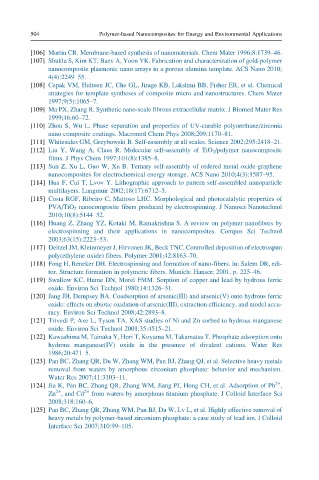Page 551 - Polymer-based Nanocomposites for Energy and Environmental Applications
P. 551
504 Polymer-based Nanocomposites for Energy and Environmental Applications
[106] Martin CR. Membrane-based synthesis of nanomaterials. Chem Mater 1996;8:1739–46.
[107] Shukla S, Kim KT, Baev A, Yoon YK. Fabrication and characterization of gold-polymer
nanocomposite plasmonic nano arrays in a porous alumina template. ACS Nano 2010;
4(4):2249–55.
[108] Cepak VM, Hulteen JC, Che GL, Jirage KB, Lakshmi BB, Fisher ER, et al. Chemical
strategies for template syntheses of composite micro and nanostructures. Chem Mater
1997;9(5):1065–7.
[109] Ma PX, Zhang R. Synthetic nano-scale fibrous extracellular matrix. J Biomed Mater Res
1999;46:60–72.
[110] Zhou S, Wu L. Phase separation and properties of UV-curable polyurethane/zirconia
nano composite coatings. Macromol Chem Phys 2008;209:1170–81.
[111] Whitesides GM, Grzybowski B. Self-assembly at all scales. Science 2002;295:2418–21.
[112] Liu Y, Wang A, Claus R. Molecular self-assembly of TiO 2 /polymer nanocomposite
films. J Phys Chem 1997;101(8):1385–8.
[113] Sun Z, Xu L, Guo W, Xu B. Ternary self-assembly of ordered metal oxide-graphene
nanocomposites for electrochemical energy storage. ACS Nano 2010;4(3):1587–95.
[114] Hua F, Cui T, Lvov Y. Lithographic approach to pattern self-assembled nanoparticle
multilayers. Langmuir 2002;18(17):6712–5.
[115] Costa RGF, Ribeiro C, Mattoso LHC. Morphological and photocatalytic properties of
PVA/TiO 2 nanocomposite fibers produced by electrospinning. J Nanosci Nanotechnol
2010;10(8):5144–52.
[116] Huang Z, Zhang YZ, Kotaki M, Ramakrishna S. A review on polymer nanofibers by
electrospinning and their applications in nanocomposites. Compos Sci Technol
2003;63(15):2223–53.
[117] Deitzel JM, Kleinmeyer J, Hirvonen JK, Beck TNC. Controlled deposition of electrospun
poly(ethylene oxide) fibers. Polymer 2001;42:8163–70.
[118] Fong H, Reneker DH. Electrospinning and formation of nano-fibers. In: Salem DR, edi-
tor. Structure formation in polymeric fibers. Munich: Hanser; 2001. p. 225–46.
[119] Swallow KC, Hume DN, Morel FMM. Sorption of copper and lead by hydrous ferric
oxide. Environ Sci Technol 1980;14:1326–31.
[120] Jang JH, Dempsey BA. Coadsorption of arsenic(III) and arsenic(V) onto hydrous ferric
oxide: effects on abiotic oxidation of arsenic(III), extraction efficiency, and model accu-
racy. Environ Sci Technol 2008;42:2893–8.
[121] Trivedi P, Axe L, Tyson TA. XAS studies of Ni and Zn sorbed to hydrous manganese
oxide. Environ Sci Technol 2001;35:4515–21.
[122] Kawashima M, Tainaka Y, Hori T, Koyama M, Takamatsu T. Phosphate adsorption onto
hydrous manganese(IV) oxide in the presence of divalent cations. Water Res
1986;20:471–5.
[123] Pan BC, Zhang QR, Du W, Zhang WM, Pan BJ, Zhang QJ, et al. Selective heavy metals
removal from waters by amorphous zirconium phosphate: behavior and mechanism.
Water Res 2007;41:3103–11.
2+
[124] Jia K, Pan BC, Zhang QR, Zhang WM, Jiang PJ, Hong CH, et al. Adsorption of Pb ,
2+
Zn , and Cd 2+ from waters by amorphous titanium phosphate. J Colloid Interface Sci
2008;318:160–6.
[125] Pan BC, Zhang QR, Zhang WM, Pan BJ, Du W, Lv L, et al. Highly effective removal of
heavy metals by polymer-based zirconium phosphate: a case study of lead ion. J Colloid
Interface Sci 2007;310:99–105.

